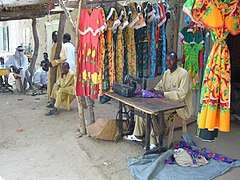Economy of Chad
 A tailor in Chad | |
| Currency | Central African CFA franc (XAF) |
|---|---|
| Calendar year | |
Trade organisations | AU, WTO |
| Statistics | |
| GDP | $11.02 billion (2012 est.) |
GDP growth |
2.8% (2015), -6.3% (2016), -3.0% (2017e), 2.6% (2018f) [1] |
GDP per capita | $885.11 (2012 est.) |
GDP by sector | agriculture: 52.7%; industry: 6.7%; services: 40.6% (2011 est.) |
| 2% (2011 est.) | |
Population below poverty line | 80% (2001 est.) |
Labour force | 4.293 million (2007) |
Labour force by occupation | agriculture: 80% (subsistence farming, herding, and fishing); industry and services: 20% (2006 est.) |
Main industries | oil, cotton textiles, meatpacking, brewing, natron (sodium carbonate), soap, cigarettes, construction materials |
| 180th (2017)[2] | |
| External | |
| Exports | $4.114 billion (2011 est.) |
Export goods | oil, cattle, cotton, gum arabic |
Main export partners |
|
| Imports | $3.512 billion (2011 est.) |
Import goods | machinery and transportation equipment, industrial goods, foodstuffs, textiles |
Main import partners |
|
FDI stock | $4.5 billion (2006 est.) |
Gross external debt | $1.769 billion (2011 est.) |
| Public finances | |
| Revenues | $2.501 billion (2011 est.) |
| Expenses | $3.482 billion (2011 est.) |
| Economic aid | $238.3 million (recipient) note - $125 million committed by Taiwan (1997); $30 million committed by African Development Bank; ODA $150 million (2001) |
Foreign reserves | $887.5 million (31 December 2011 est.) |
Landlocked Chad's economic development suffers from its geographic remoteness, drought, lack of infrastructure, and political turmoil. About 85% of the population depends on agriculture, including the herding of livestock. Of Africa's Francophone countries, Chad benefited least from the 50% devaluation of their currencies in January 1994. Financial aid from the World Bank, the African Development Bank, and other sources is directed largely at the improvement of agriculture, especially livestock production. Because of lack of financing, the development of oil fields near Doba, originally due to finish in 2000, was delayed until 2003. It was finally developed and is now operated by Exxon Mobil Corporation.
Macro-economic trend
The following table shows the main economic indicators in 1980–2017.
| Year[5] | 1980 | 1985 | 1990 | 1995 | 2000 | 2005 | 2006 | 2007 | 2008 | 2009 | 2010 | 2011 | 2012 | 2013 | 2014 | 2015 | 2016 | 2017 |
|---|---|---|---|---|---|---|---|---|---|---|---|---|---|---|---|---|---|---|
| GDP in $ (PPP) |
1.90 Bln. | 3.04 Bln. | 4.41 Bln. | 5.77 Bln. | 7.12 Bln. | 16.09 Bln. | 16.69 Bln. | 17.70 Bln. | 18.60 Bln. | 19.51 Bln. | 22.44 Bln. | 22.93 Bln. | 25.41 Bln. | 27.30 Bln. | 29.71 Bln. | 30.56 Bln. | 28.96 Bln. | 28.55 Bln. |
| GDP per capita in $ (PPP) |
433 | 610 | 781 | 874 | 952 | 1,781 | 1,802 | 1,864 | 1,911 | 1,956 | 2,195 | 2,188 | 2,366 | 2,480 | 2,633 | 2,642 | 2,443 | 2,344 |
| GDP Growth (real) |
−6.0 % | 7.9 % | 3.2 % | −0.8 % | −0.9 % | 28.5 % | 0.6 % | 3.3 % | 3.1 % | 4.1 % | 13.6 % | 0.1 % | 8.8 % | 5.8 % | 6.9 % | 1.8 % | −6.4 % | −3.1 % |
| Government debt (Percentage of GDP) |
... | ... | ... | ... | 68 % | 28 % | 26 % | 22 % | 20 % | 32 % | 30 % | 31 % | 29 % | 31 % | 42 % | 44 % | 52 % | 53 % |
See also
References
- ↑ "World Bank forecasts for Chad, June 2018 (p. 153)" (PDF). World Bank. Retrieved 11 September 2018.
- ↑ "Ease of Doing Business in Chad". Doingbusiness.org. Retrieved 2017-01-23.
- ↑ "Export Partners of Chad". CIA World Factbook. 2015. Retrieved 26 July 2016.
- ↑ "Import Partners of Chad". CIA World Factbook. 2015. Retrieved 26 July 2016.
- ↑ "Report for Selected Countries and Subjects". www.imf.org. Retrieved 2018-08-24.
- General

